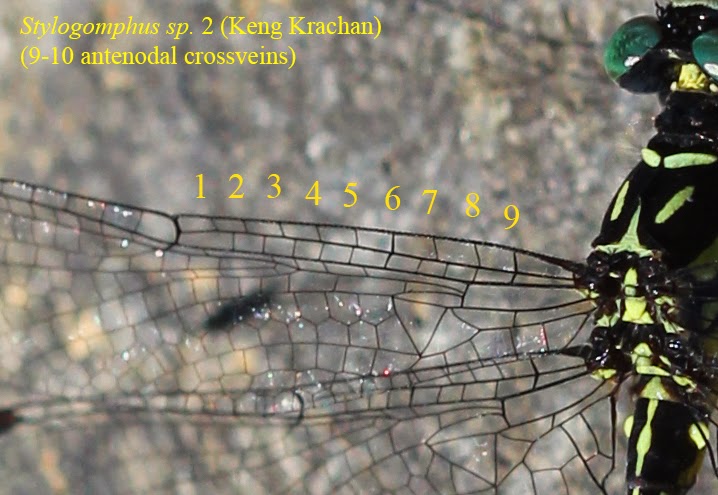Number: 169
Family: Gomphidae
Genus: Stylogomphus sp. 2
Species: Stylogomphus sp. (yet to be described)
Common name(s):N/A
Synonyms: N/A
Habitat: Forested rocky stream
Province(s) sighted: Pa La-U Waterfall (Pratchup Khirikhan)
Sightings (by me): Several males and one female
In flight (that I have seen): May (2014)
Species easily confused with: -
Family: Gomphidae
Genus: Stylogomphus sp. 2
Species: Stylogomphus sp. (yet to be described)
Common name(s):N/A
Synonyms: N/A
Habitat: Forested rocky stream
Province(s) sighted: Pa La-U Waterfall (Pratchup Khirikhan)
Sightings (by me): Several males and one female
In flight (that I have seen): May (2014)
Species easily confused with: -
Working my way carefully up the beautiful Pa La-U waterfall, a tiny female Gompid landed right between my legs (I almost stood on it). I managed to get some decent photos of it from above and then it flew away. I had no idea what it was and it was easily the smallest Gomphid I had ever seen. Then, I saw a similar-sized male. Then another and another. There were at least 6-7 males present and I was able to get some decent photos of them. When I returned home, I posted my findings on "Dragonflies of Thailand" on Facebook and the feedback was unanimous (Noppadon Makbun, Pattarawich Dawwrueng, Kroolek Reinthong): Stylogomphus sp. (not yet described as far as I am aware). I had actually seem a solitary male once before at Nam Nao NP, but that one was much larger in size, whereas these were tiny. Also, I think the appendages differ slightly too. However, where I can tell the difference from my photos (and not just memory), is through the number of antenodal crossviens. Stylogomphus sp. 2 from Kaeng Krachan has 9-10 antenodal crossveins, whereas Stylogomphus sp. 1 from Petchabun has 15. You can see images of the Petchabun specimen here.
The male
A tiny fellow that doesn't seem to fly far, but instead flies from rock to rock. Though superficially a typical-looking Gomphid, its appendages are unique (which is what gives it is name, I believe).
The appendages are like the stylus of an old record player (hence its name) ...
Wing venation
Here, you can easily compare the crossveins of the species I found at Kaeng Krachan and Petchabun. Somewhat different I think!
... and another specimen with 10 antenodal crossveins ...
The female
The female is difficult to ID. However, it was also tiny making life easy for me (I only managed photos from this angle as it was perching directly between my feet).
+-+0553.jpg)
+-+0538.jpg)
+-+0500.jpg)
+-+0480.jpg)
+-+0515.jpg)
+-+0546.jpg)



+-+0470.jpg)
+-+0474.jpg)
hello,, i'm just visit,, have a nice day :D
ReplyDelete